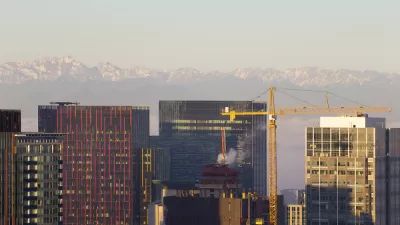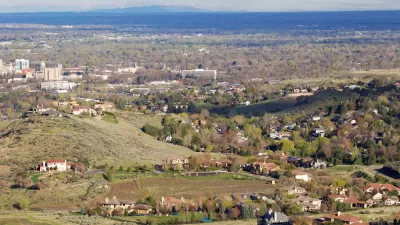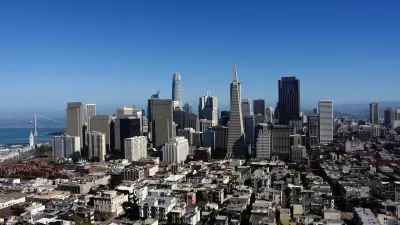Too many city plans represent business-as-usual, sit on a shelf collecting dust, or miss the chance to reflect a truly game-changing moment in the direction of a city. Want your new city plan process to result in a great plan? Consider these 10 keys.

One of the most interesting and complex challenges a city planner can be a part of, is the creation of a new city-wide plan—particularly one for an ambitious municipality that truly wants to change business-as-usual. Over my career I've worked on many city plans, both here in Canada and outside of North America.
I hadn't realized the amount of pent-up perspective I had accumulated on the matter of successful plan-making, until I began working with city staff and my consulting team partners at DIALOG on a new city-wide plan for Abbotsford, British Columbia. Who'd have thought that it would be a plan for a city just up the highway that would end up being one of my most interesting case studies in better plan-making.
Our Abbotsford process, officially dubbed "AbbotsForward" (or #AbbotsFWD for the hashtag savvy) has already been a rich opportunity to rethink the business-as-usual of municipal plan-making…and we're not done yet! In short, this is a plan worth watching. You can easily eavesdrop by following along on twitter at @Abbotsforward.
A seemingly small but surprisingly powerful early step in this new way to plan-make was my impromptu assembly of a list of "Top 10 Keys to a Great Plan," shared in an early presentation to staff and city council. It was the product of some hard learnings and even frustration from past exercises—perhaps it started as a little self-therapy! But we started repeating it at meeting after meeting, and it quickly became an official "magic mirror" to hold each step of our process up against. Staff even turned the 10 into a graphic for tweeting, putting them out there front and centre in the community conversation.
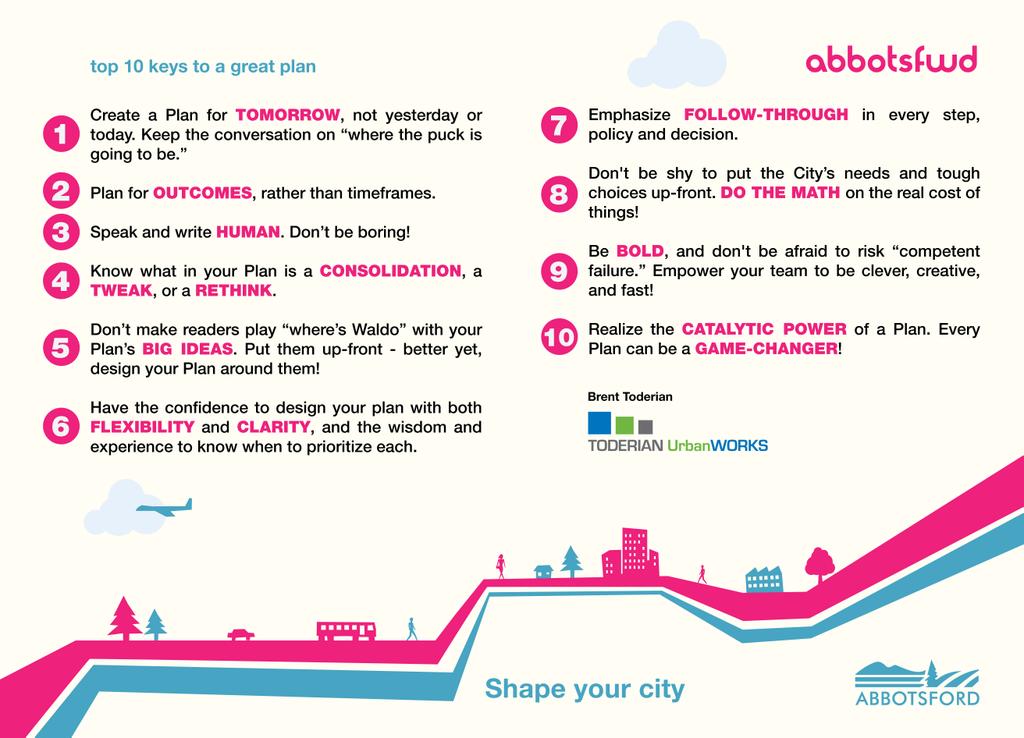
Although they aren’t meant to automatically apply to every city, and I wouldn't even necessarily write the same list myself for the next plan I work on, I thought you might find them interesting and worth discussing in your own plan-making exercise. Here they are, with a taste of how I originally explained them:
10 Keys to a Great Plan
1) Create a plan for TOMORROW, not yesterday or today. Keep the conversation on "where the puck is GOING to be."
Plan-making conversations can easily end up being neutered by what seems possible today, or "what the community might be ready for," when a plan is supposed to be about the future, not just the present or past. At the end of a plan-making process, I once asked a team I was working with if they thought we had made a plan for yesterday, today, or tomorrow? Their honest answer was that it was a plan for today—and they were rightfully disappointed with that answer. I still remember the look in their eyes as they admitted it. We had let the process be limited to today's perceived comfort levels instead of tomorrow's challenges, needs and opportunities, and in doing so, the plan we made felt out of date on the day it was passed. I'll always remember that look, and I promised myself I'd never be part of that kind of disappointing result again.
And of course, as a Canadian, you just can't go wrong quoting Wayne Gretzky. Skate to where the puck is going to be.
2) Plan for OUTCOMES, rather than time-frames.
A big example of this is how most plans set a time-frame of 20 years or so, and then, among other things, they include a population estimate for how the community might grow over that time-frame. Those numbers aren't a target, mind you—just a projection. I myself have done that many times, but I'm no longer a fan of doing it.
In recent plans I've worked on, including AbbotsForward, we've made the key decision to plan for a city at a specific population level—in other words, for an outcome—regardless of how long it takes to reach that population. It might be 10 or 15 years, or it might be 25 or 30 years. That population outcome won't be the end of growth, to be clear—just the basis for the current plan and its policies (and of course, the plan must telegraph further growth beyond that outcome, since growth doesn't just stop at that number). The important thing isn't the speed of growth, but the nature of growth. It's based in part on the realization that planning has a lot more control over the "what" than the "when." Frankly, the one thing we know about population projections, which tend to project past trends forward assumming the future will be the same as the past, is that they will be wrong—by how much and in which direction tend to be the only surprises.
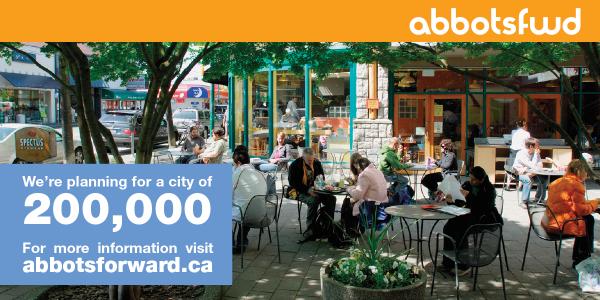
Planning for outcomes, including a specific population level, powerfully changes everything in the plan-making process for the better, from the way we frame the public conversation (watch this), to the way we connect servicing and land-use decisions. The conversation focuses on how we are going to "land" those additional people in ways that will meet our goals for a different city at the NEW population than we were at the OLD population. In my observation, every ripple effect of that decision has led to better conversations, more focused work, and better results, and everyone from the mayor, to the public, to the city engineers have applauded the different approach.
3) Speak and write HUMAN. Don't be boring!
There are many creative and effective ways to design a much more "engaging engagement." I tend to think that doing better starts with the idea that people are busy, and you have to give them opportunities to participate in ways that are interesting and convenient for THEM, not just for you. It should go without saying though, that no technique, old or new, will succeed if you're boring!
And here’s the problem—too many planning processes are. Overly technical language; bland, bureaucratic events; and safe, sterile presentations—it's no wonder many people think planning processes are a mind-numbing snooze-fest. But it doesn't have to be that way, and really shouldn't be, since cities are inherently interesting things, and I've found that people are intensely interested in the future of the places where they live. So it starts by admitting that if the planning conversation is boring, it's our fault! The solution isn’t hard to figure out—stop being boring!
One place to start is to write and speak like citizens do, not like "professionals" do. You won't seem less intelligent—you'll just be more interesting.
4) Know WHAT in your plan is a consolidation, a tweak, and a rethink.
Many plan-making exercises I've worked on have started with clients suggesting that "we're really just doing a consolidation, because the policy we have is pretty good." Other clients have suggested that we might as well throw out the plan we have, and start fresh. Both are wrong.
Every plan-making process in truth is a combination of consolidating, tweaking, and fundamentally rethinking different aspects of your city's direction. The art is in the organization, and in some cases the debate and discovery, around which issue or existing policy falls into which of the three categories. Lately, I've liked overtly organizing existing policy into those three categories, almost line-by-line. It's a disciplined way to really consider the true nature of the policy you're considering, and an effective way to focus your creative energy on the bigger opportunities where rethinking is truly on the table.
5) Don't make readers play "where's Waldo" with your plan's BIG IDEAS. Put them up-front—better yet, design your plan around them!
Every plan has BIG IDEAS—powerful policies or statements that, if actually implemented, have the potential to significantly change the city. Many of these are incredibly hard to find in the plan. It's almost as if we're TRYING to hide them!
With one client of mine, as we were reviewing a draft plan, I observed that a short paragraph of policy that was tucked into page so-and-so, in section blah, sub-section blah blah, was so powerful that if implemented, it would fundamentally change the city…if anyone ever found it or knew it existed! Policies that are hard to find are hard to care about, and easy to ignore or forget.
My advice to that client, and every client since, has been to pull those big, powerful ideas out of the obscure sub-sections of your plan, and put them front and centre in your conversation, and ultimately in your document. Why not turn them into the chapters of your plan? In other words, design your plan around them, and make them matter!
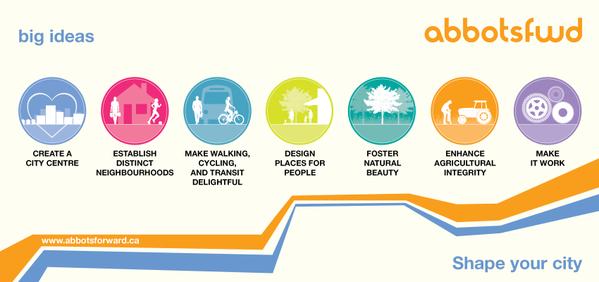
6) Have the confidence to design your plan with both FLEXIBILITY and CLARITY, and the wisdom and experience to know when to prioritize each.
Possibly the biggest debate in plan-making these days is the debate about whether plans should be "firm and clear," so they can provide the clarity that everyone says they need from a plan, or whether they should be flexible to allow for the better ideas that will no doubt come along during the life of a plan. The answer, of course, is that great plans need both.
The art, based on experience and understanding regarding follow-through, is to know which parts of the plan need firmness and clarity, for everything from speculation-killing to political sanity, and which parts need to allow for the better idea that would help achieve the plan's big ideas. The tough part is of course that everyone thinks their ideas are better (even though most aren't), and cities are often so concerned about the pressure they will get to accept every idea, that they feel the need to write overly ridged plans that say no to everything except what the plan clearly allows. A mature, confident city, though, crafts a plan that knows when flexibility for the better idea is needed, and when clarity and firmness is needed -- and they build a staff that knows a better idea when they hear one.
7) Emphasize FOLLOW-THROUGH in every step, policy and decision.
There's a not-so-old saying among city planning geeks—"To plan is human; to implement, divine." And yet too many plans give too little thought to the implementation and follow-through, not just in the sense of the development approvals side where growth actually gets built, but also in the city hall details and needs around operations, maintenance, etc.
Now lets be clear—I'm not a fan of letting the operational and maintenance sides of things kill creative new policy ideas and better visions, as I've seen them do, just because it would mean operational changes in practice, budget or equipment. That's just letting the tail wag the dog. But good policy ALWAYS has successful follow-through in mind.
Good policy-making sees six chess moves ahead, and knows how to make sure the plan doesn't wind up sitting on a shelf collecting dust. Increasingly, good plans build the follow-through right into the document—in sections or chapters like "Making the Plan Real" or "Making it Work."
At the highest level though, a big part of the successful implementation of a plan is in the organizational and political culture change that is necessary to really make the plan a reality. This includes creating the political buy-in needed for the plan to matter, and the political will to fight for the plan when it's inevitably challenged. More on that in #10.
8) Don't be shy to put the cities needs and tough choices up-front. Do the math!
When it comes to public engagement in a plan, fears of looking like a city has "made up its mind" (one extreme) can lead to efforts to appear like you’re starting with the proverbial "blank sheet of paper" (the other extreme). But in my experience, cities NEVER have a blank sheet of paper, and they've also NEVER fully made up their mind before the plan-making starts.
The truth is, most cities these days have better data on city-making, including better math on the true costs and consequences of the choices around how they grow, than ever before (if you’re city HASN'T started doing this "new math," you really need to make it a priority). In my experience, this math can have a transformative effect on the political and community conversation about growth and planning, partially because it can transcend political positions and ideologies of "left" and "right."
Cities should be brave and unapologetic in producing and sharing this "new math" with their citizens. That doesn't mean they can't still learn more from the people, and rethink aspects the math and what it means, and it certainly doesn't mean they've pre-made decision on the necessarily new directions and solutions coming from that math. But the point is that no plan starts from scratch, and cities shouldn't be shy about putting valuable and important information and data, communicated with compelling and interesting story-telling (and cool infographics), out there from the very beginning to foster a great conversation.
9) Be BOLD, and don't be afraid to risk "competent failure." Empower your team to be clever, creative, and fast!
In the corporate culture that shapes plan-making (and just about everything else), there will be dozens of moments where the choice of taking a risk, or playing it safe, will make all the difference between a creative new approach, and "business-as-usual." If a city wants a new plan to truly create change for the better, then it will likely take a different process, different decisions, and ultimately a different plan to do that. You know that old line about "the definition of insanity!"
None of that is without risk, but as my friend Charles Landry (author of The Creative City and many other great books) puts it, there's a big difference between "competent risk" (where failure can lead to learning and improvement) and incompetent failure that results from just not thinking it through. Cities that have built great plans and successful results usually showed boldness of thought and action; took competent, well-considered risks; and empowered their staff to be interactive in a fast, real-time way without multiple barriors of beaurocratic oversight.
A small but real example of this is in a social media strategy for plan-making—do you have multiple layers of micro-managing every time you want to send a tweet? Do you even allow tweeting (watch this)?
10) Realize the CATALYTIC power of a plan. Every plan can be a game-changer!
Some cities see new plans as a chance to get better policy, and if that's their goal, chances are that's what they'll get. To be clear, that's not a small thing. Other cities though, think bigger. The creation of a new plan can represent a once-in-a-generation chance for a profound change in direction, in everything from policy; to creative corporate culture; to council, staff, and the community's conversations around smarter, more successful city-making. In short, it's not a moment to be squandered!
I often point out to cities that ask about Vancouver's hosting of Expo '86 or the 2010 Winter Olympics (undoubtedly catalytic moments in Vancouver's city-making), that a powerful new plan can be just as significant a game-changing moment, if the opportunity is fully embraced. If you think of a plan as just another book of policy, undoubtedly that's what it will be. If you see a plan as a turning point for your city, a game-changer, and put all your energy and creativity into making it that—well, that's also what it will be.
------------------------------------
As we've continued the AbbotsForward process, there've been many other steps and moments of creativity and momentum that have kept me optimistic that a special plan is going to result from our shared efforts. Of particular importance is the effort we've been putting into preparing everyone for the inevitable tough choices and controversial debates to come, where we'll really have to look at ourselves in our 10-point "magic mirror" and ask "how badly do we want this?"
But I've found that how plan-making ultimately finishes, depends a lot on how it starts. In our case, starting with these "10 Keys To Making A Great Plan" has had a powerful effect on every step since.
Will I create a NEW list of "keys" the next time I start a plan, based on what I've learned on this one? Absolutely. I invite you to share your OWN keys on great plan-making, based on your own hard learnings.

Planetizen Federal Action Tracker
A weekly monitor of how Trump’s orders and actions are impacting planners and planning in America.

Restaurant Patios Were a Pandemic Win — Why Were They so Hard to Keep?
Social distancing requirements and changes in travel patterns prompted cities to pilot new uses for street and sidewalk space. Then it got complicated.

Map: Where Senate Republicans Want to Sell Your Public Lands
For public land advocates, the Senate Republicans’ proposal to sell millions of acres of public land in the West is “the biggest fight of their careers.”

Maui's Vacation Rental Debate Turns Ugly
Verbal attacks, misinformation campaigns and fistfights plague a high-stakes debate to convert thousands of vacation rentals into long-term housing.

San Francisco Suspends Traffic Calming Amidst Record Deaths
Citing “a challenging fiscal landscape,” the city will cease the program on the heels of 42 traffic deaths, including 24 pedestrians.

California Homeless Arrests, Citations Spike After Ruling
An investigation reveals that anti-homeless actions increased up to 500% after Grants Pass v. Johnson — even in cities claiming no policy change.
Urban Design for Planners 1: Software Tools
This six-course series explores essential urban design concepts using open source software and equips planners with the tools they need to participate fully in the urban design process.
Planning for Universal Design
Learn the tools for implementing Universal Design in planning regulations.
Heyer Gruel & Associates PA
JM Goldson LLC
Custer County Colorado
City of Camden Redevelopment Agency
City of Astoria
Transportation Research & Education Center (TREC) at Portland State University
Camden Redevelopment Agency
City of Claremont
Municipality of Princeton (NJ)



























